Fig. 2. Sleep increase after starvation does not depend on sleep loss.

A: Sleep profile of akh mutants during 24-h fed ad lib (n = 16) or starved (n = 31) (left panel) and during 24-h fed ad lib (n = 16) or starved > fed (n = 31) (right panel). B: Sleep profile of trsn mutants during 24-h fed ad lib (n = 16) or starved (n = 30) (left panel) and during 24-h fed ad lib (n = 16) or starved > fed (n = 30) (right panel). C: Quantification of sleep differences between 24-h fed ad lib and starved groups of akh, trsn and their respective wild-type controls. Sleep was suppressed in all wild-type starved groups, but not in akh and trsn mutants (P < 0.0001 for wild type; P > 0.3167 for akh or trsn mutants). D: Quantification of sleep differences between 4-h fed ad lib and starved > fed groups of akh, trsn, and their respective wild-type controls. Sleep was increased in the first 4 h in all starved > fed groups (P < 0.0001). E: Activity index for akh mutants (n = 64) and wild-type control (n = 64) under fed ad lib conditions. Activity is lowered in akh mutants compared to wild-type control (P < 0.0001).
